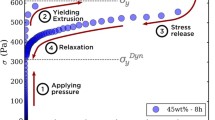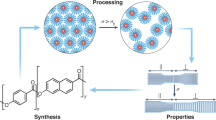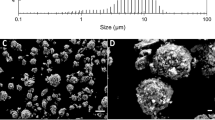Abstract
Direct ink writing (DIW) is a versatile additive manufacturing technique capable of printing 3D architectures from a broad range of materials. The key advantage of DIW is the ability to spatially control both the architecture and the composition of the printed part, which enables the production of components with previously unachievable combinations of functionalities. One emergent application space for DIW has been in additively manufactured glass optics, where a “green body” is patterned layer-by-layer by extruding a silica-based slurry through a microfluidic nozzle and then thermally consolidated to transparent glass. A critical aspect of the process is ensuring that the printed part is completely free of voids that can occur in the interstitial spaces between the extruded filaments. This outcome is governed by the interplay between ink rheology and strains imposed by the printing process and geometric packing of the filaments. Here, we explore the strain- and rate-dependent deformation events in the DIW process to determine conditions that enable the printing of void-free monoliths without sacrificing shape fidelity. We focus on yield stress fluids consisting of fumed silica nanoparticles dispersed in organic solvents at varied volume fractions to control the rheological properties. We investigate the printability of these ink materials as a function of print process variables and devise the appropriate dimensionless parameters that capture the geometry-dependent and rate-dependent effects on the deformation of the extruded ink. Finally, we use these scaling arguments to construct a phase diagram for void-free monolith printability.
Graphical abstract










Similar content being viewed by others
References
Coussot P (2014) Yield stress fluid flows: a review of experimental data. J Nonnewton Fluid Mech 211:31–49. https://doi.org/10.1016/j.jnnfm.2014.05.006
Das A, Gilmer EL, Biria S, Bortner MJ (2021) Importance of polymer rheology on material extrusion additive manufacturing: correlating process physics to print properties. ACS Appl Polymer Mater. https://doi.org/10.1021/acsapm.0c01228
Derjaguin BV, Muller VM, Toporov YuP (1975) Effect of contact deformations on the adhesion of particles. J Colloid Interface Sci 53:314–326. https://doi.org/10.1016/0021-9797(75)90018-1
Destino JF, Dudukovic NA, Johnson MA et al (2018) 3D printed optical quality silica and silica–titania glasses from sol–gel feedstocks. Adv Mater Technol 3:1700323. https://doi.org/10.1002/admt.201700323
Dudukovic NA, Wong LL, Nguyen DT et al (2018) Predicting nanoparticle suspension viscoelasticity for multimaterial 3D printing of silica–titania glass. ACS Appl Nano Mater 1:4038–4044. https://doi.org/10.1021/acsanm.8b00821
Durban MM, Lenhardt JM, Wu AS et al (2018) Custom 3D printable silicones with tunable stiffness. Macromol Rapid Commun 39:1700563. https://doi.org/10.1002/marc.201700563
Dylla-Spears R, Yee TD, Sasan K et al (2020) 3D printed gradient index glass optics. Sci Adv 6:eabc7429. https://doi.org/10.1126/sciadv.abc7429
Engmann J, Servais C, Burbidge AS (2005) Squeeze flow theory and applications to rheometry: a review. J Nonnewton Fluid Mech 132:1–27. https://doi.org/10.1016/j.jnnfm.2005.08.007
Golobic AM, Durban MD, Fisher SE et al (2019) Active mixing of reactive materials for 3D printing. Adv Eng Mater 21:1900147. https://doi.org/10.1002/adem.201900147
Greer JR, Deshpande VS (2019) Three-dimensional architected materials and structures: design, fabrication, and mechanical behavior. MRS Bull 44:750–757. https://doi.org/10.1557/mrs.2019.232
Ha J, Sasan K, Yee TD, et al. (n.d.) Refractive index and abbe number tuning via 3D printable optical quality silica–titania–germania glasses. Adv Photon Res 2200017. https://doi.org/10.1002/adpr.202200017
Holness FB, Price AD (2017) Direct ink writing of 3D conductive polyaniline structures and rheological modelling. Smart Mater Struct 27:015006. https://doi.org/10.1088/1361-665X/aa981c
Hyun K, Wilhelm M, Klein CO et al (2011) A review of nonlinear oscillatory shear tests: analysis and application of large amplitude oscillatory shear (LAOS). Prog Polym Sci 36:1697–1753. https://doi.org/10.1016/j.progpolymsci.2011.02.002
Johnson KL, Kendall K, Roberts AD, Tabor D (1971) Surface energy and the contact of elastic solids. Proc R Soc London A Math Phys Sci 324:301–313. https://doi.org/10.1098/rspa.1971.0141
Jones IK, Seeley ZM, Cherepy NJ et al (2018) Direct ink write fabrication of transparent ceramic gain media. Opt Mater 75:19–25. https://doi.org/10.1016/j.optmat.2017.10.005
Kamani K, Donley GJ, Rogers SA (2021) Unification of the rheological physics of yield stress fluids. Phys Rev Lett 126:218002. https://doi.org/10.1103/PhysRevLett.126.218002
Kotz F, Arnold K, Bauer W et al (2017) Three-dimensional printing of transparent fused silica glass. Nature 544:337–339. https://doi.org/10.1038/nature22061
Lee EH, Radok JRM (1960) The contact problem for viscoelastic bodies. J Appl Mech 27:438–444. https://doi.org/10.1115/1.3644020
Lewis JA, Gratson GM (2004) Direct writing in three dimensions. Mater Today 7:32–39. https://doi.org/10.1016/S1369-7021(04)00344-X
M’Barki A, Bocquet L, Stevenson A (2017) Linking rheology and printability for dense and strong ceramics by direct ink writing. Sci Rep 7:6017. https://doi.org/10.1038/s41598-017-06115-0
McIlroy C, Olmsted PD (2017) Deformation of an amorphous polymer during the fused-filament-fabrication method for additive manufacturing. J Rheol 61:379–397. https://doi.org/10.1122/1.4976839
Mewis J, Wagner NJ (2012) Colloidal suspension rheology. Cambridge University Press
Nguyen DT, Meyers C, Yee TD et al (2017) 3D-printed transparent glass. Adv Mater 29:1701181. https://doi.org/10.1002/adma.201701181
Owens CE, Hart AJ, McKinley GH (2020) Improved rheometry of yield stress fluids using bespoke fractal 3D printed vanes. J Rheol 64:643–662. https://doi.org/10.1122/1.5132340
Raghavan SR, Walls HJ, Khan SA (2000) Rheology of silica dispersions in organic liquids: new evidence for solvation forces dictated by hydrogen bonding. Langmuir 16:7920–7930. https://doi.org/10.1021/la991548q
Roussel N, Coussot P (2005) “Fifty-cent rheometer” for yield stress measurements: from slump to spreading flow. J Rheol 49:705–718. https://doi.org/10.1122/1.1879041
Sasan K, Lange A, Yee TD et al (2020) Additive manufacturing of optical quality germania–silica glasses. ACS Appl Mater Interfaces. https://doi.org/10.1021/acsami.9b21136
Singh PK, Lee JC-W, Patankar KA, Rogers SA (2021) Revisiting the basis of transient rheological material functions: insights from recoverable strain measurements. J Rheol 65:129–144. https://doi.org/10.1122/8.0000154
Smay JE, Cesarano J, Lewis JA (2002) Colloidal inks for directed assembly of 3-D periodic structures. Langmuir 18:5429–5437. https://doi.org/10.1021/la0257135
Wang Q, Jackson JA, Ge Q et al (2016) Lightweight mechanical metamaterials with tunable negative thermal expansion. Phys Rev Lett 117:175901. https://doi.org/10.1103/PhysRevLett.117.175901
Wyss HM, Miyazaki K, Mattsson J et al (2007) Strain-rate frequency superposition: a rheological probe of structural relaxation in soft materials. Phys Rev Lett 98:238303. https://doi.org/10.1103/PhysRevLett.98.238303
Yuk H, Zhao X (2018) A new 3D printing strategy by harnessing deformation, instability, and fracture of viscoelastic inks. Adv Mater 30:1704028. https://doi.org/10.1002/adma.201704028
Zheng X, Lee H, Weisgraber TH et al (2014) Ultralight, ultrastiff mechanical metamaterials. Science 344:1373–1377. https://doi.org/10.1126/science.1252291
Zheng X, Smith W, Jackson J et al (2016) Multiscale metallic metamaterials. Nat Mater 15:1100–1106. https://doi.org/10.1038/nmat4694
Zhu C, Han TY-J, Duoss EB et al (2015) Highly compressible 3D periodic graphene aerogel microlattices. Nat Commun 6:1–8. https://doi.org/10.1038/ncomms7962
Zhu C, Pascall AJ, Dudukovic N et al (2019) Colloidal materials for 3D printing. Annu Rev Chem Biomol Eng 10:17–42. https://doi.org/10.1146/annurev-chembioeng-060718-030133
Author information
Authors and Affiliations
Corresponding author
Additional information
Publisher's note
Springer Nature remains neutral with regard to jurisdictional claims in published maps and institutional affiliations.
Supplementary Information
Below is the link to the electronic supplementary material.
Rights and permissions
Springer Nature or its licensor holds exclusive rights to this article under a publishing agreement with the author(s) or other rightsholder(s); author self-archiving of the accepted manuscript version of this article is solely governed by the terms of such publishing agreement and applicable law.
About this article
Cite this article
Dudukovic, N.A., Ellis, M.E., Foster, M.M. et al. 3D printing of void-free glass monoliths: rheological and geometric considerations. Rheol Acta 61, 773–784 (2022). https://doi.org/10.1007/s00397-022-01367-8
Received:
Revised:
Accepted:
Published:
Issue Date:
DOI: https://doi.org/10.1007/s00397-022-01367-8




